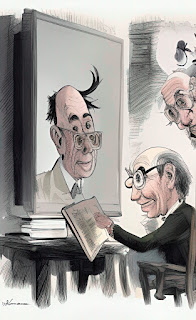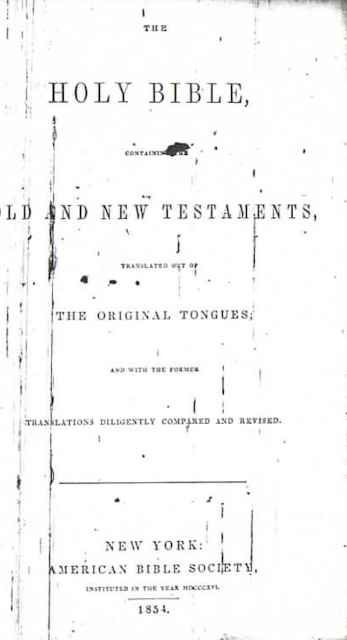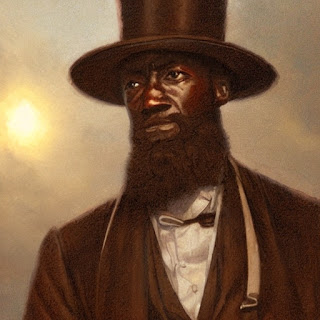 |
| Mr. Tapscott |
Whose Evangelicalism?
.jpg) |
| white evangelicals (made on dream.ai) |
instance, one may be a socially conservative evangelical and hold to Democratic Socialism in many respects. European evangelicals are not necessarily right-wing in the way that "American" evangelicals invariably posture themselves. One example of this is found in the book by British historian Carl F. Trueman, Republocrat: Confessions of a Liberal Conservative. In 19th century terms, Brown was a left-of-center evangelical--which is to say that his theology was very conservative while his politics were "radical" compared to proslavery conservatives. In contrast, Mark Tapscott represents a tradition that, in Brown's time, counseled in favor of the legal rights of slaveholders, subordination of black people's human concerns to white people's preeminence, and harshly rejected any demand for immediate emancipation as "radical." So the question for Mark Tapscott is, "whose evangelicalism is really scripturally faithful?"
So, given that evangelical has become associated with politics in the USA, it has increasingly become entangled with the right-wing so that the term has been all but ruined for theological discussions. The wedding and bedding of evangelical by the rightwing whites have thus rendered it increasingly reactionary and hostile toward anything that challenges the status quo as they see it, the culmination of which was the rise of Trump, which some would say has brought utter ruin to the party of Lincoln. Certainly, the fixed intent of conservative evangelical watchdogs like Tapscott is to protect the top-down narrative of US history--a narrative that has treated slavery more as an unpleasant (parenthesis) and made powerful white men the basis of its claims.
This is why Tapscott has sounded the alarm of complaint about my article. It clearly galls him that another Christian, writing in an evangelical publication, should suggest that John Brown should be understood any differently than as a fanatic and killer.
An Authority on the Subject?
Tapscott’s claim to making an authoritative reading of Brown is based on “a great deal of time” spent in the 1970s, when he says he carefully read the scholarship on Brown. In other words—and this is important—Tapscott’s reading of the literature on Brown is out of date at best. What Tapscott read in those days is unclear, but even so, he's running on the fumes of his own past. I wonder, has Tapscott read my religious life of John Brown? Has he read the epic cultural biography by David S. Reynolds? Probably not.
Tapscott also stakes his authoritative voice on having read “the coverage and commentary” on the 1859 Harper’s Ferry raid in “the nation’s top newspapers of that day.” Indeed, Tapscott continues, he had intended to do a doctoral dissertation on John Brown, although clearly (and thankfully) he changed course and went on to other things. Tapscott reveals, in fact, that he set aside his doctoral work in its third draft because he was called higher up—that is, he was summoned to serve in two of Reagan's presidential campaigns and other services to the actor-turned-president. Tapscott even provides the unseemly title of his unfinished opus: “John Brown and Gnostic Millenarianism in the American Political Regime.” Gnostic millennarianism?
I have never admired Ronald Reagan. I am old enough to remember his presidency and I know about his reputation as a governor before that, and I believe his record on race and racial justice exemplify the larger problem of conservativism in the US. So if this is the man to whom he devoted his youthful energies, it is really no surprise that Tapscott has taken issue with my piece in CT. Still, I am at least grateful to Reagan that he so prevailed upon a young Tapscott that he was obliged to abandon that travesty of a dissertation project, and left poor John Brown alone. Unfortunately, he has now found occasion in my article to take up his attack once again.
A Thankfully Unfinished Work
 |
| "a fabrication of his own mind" (made on dream.ai) |
Underestimation Too
Furthermore, in overestimating his own knowledge of the topic, Tapscott also underestimates me when he writes: “I know aspects of John Brown’s life that apparently escaped Professor DeCaro and which render as absurd and dangerous his encouragement that evangelicals adopt as a hero. (I should note here that Tapscott consistently misspells my name throughout his screed, which suggests how little he did his homework.) Perhaps, then, had he actually considered my work on Brown, he would not suggest that “aspects of John Brown’s life” have “apparently” escaped my attention. Quite to the contrary, the problem for Tapscott is that he has not sufficiently studied either the Pottawatomie episode of 1856 or the Harper’s Ferry raid of 1859. In fact, it appears that Tapscott’s understanding of Brown’s actions in Kansas and Virginia is skewed and misinformed by selective reading and biased presupposition—something quite typical of anti-Brown conservatives. Tapscott, like others, simply does not know what he does not know, yet he presumes his conclusions are all that there is to say about the subject. I think this is called hubris.Pottawatomie, Again
Along these lines, then, Tapscott then charges that I have obscured the record of Brown, who was a “vicious killer and a political radical with a seething desire for dictatorial power.” Of course, Tapscott is twice wrong here. Brown was not a vicious killer and the circumstances of Pottawatomie attest that his response to the proslavery terrorism that threatened his family in 1856 was harsh but tactical and delimited. As I have consistently argued, Brown and his family were literally living under the threat of imminent, murderous assault and were without appeal to protection from either territorial or federal constabularies. His harsh action in killing five pro-slavery thugs was essentially preemptive and did function to save his family in the immediate sense (his son Frederick was afterward murdered, in the summer of that same year, at the onset of a surprise proslavery invasion upon Osawatomie.) The fact that Brown and his family were alive and able to depart the Kansas territory in late 1856 is in large part due to the Pottawatomie strike. Furthermore, apart from this special incident, I would ask Tapscott where Brown figures in the record as a “vicious killer.”"Seething Desire"?
 |
| made on dream.ai |
The Real John Brown
To be sure, Brown was personally (and by his own admission) at times given toward imperiousness. But Tapscott is subverting biography in his claims, presuming in particular that it is lust for power and wealth that drove Brown to Harper's Ferry. But this is something that no capable biographer has ever argued. Were Tapscott at least fair, he would have pointed out that abundance of evidence that John Brown was also a humane, devoted man. This lack of balance is everywhere present in Tapscott's screed. He concedes nothing, even in fairness, and insists that his 1970s thesis is all we need to accept.Quite to the contrary, had Brown successfully operated a regime of fugitives in the Allegheny mountains, he would not have proven a “seething dictator” as Tapscott says, but rather as a brave and self-sacrificing leader. His devotion to the rule of law, and the values of the US. republic and the principles of his forebears would also have been significant to his leadership, even as they were throughout his efforts in Kansas and Virginia. But Tapscott ignores all of this because he is intent only on impugning Brown and making a mockery of my argument as a biographer.
Misreading Brown Reading Scripture
 |
| Title page of Brown's Prison Bible (Chicago History Museum) |
Prescient and Prophetic
Now, whether one agrees with this theological shop talk or not (and I do not assume that all my readers do), I only point this out because Tapscott says Brown tragically misunderstood this text. He claims this is so based upon Brown's famous last written words, where he says that he believed that “the crimes of this guilty land will never be purged away but with blood.” These are indeed Brown’s last written words, for he believed slavery was an immense and wicked sin that had overcome the nation. As a result, Brown held that a vast measure of slavery’s crimes was so extensive that, absent repentance on the part of slaveholders, divine justice would require judgment upon the US. Accordingly, he believed that justice would require the shedding of blood. This position was not unique, and the specter of God's judgment had haunted the nation since the early days of the nation. Perhaps the most famous evidence of this is found in the words of the slaveholder president, Thomas Jefferson, who famously wrote: "Indeed I tremble for my country when I reflect that God is just: that his justice cannot sleep for ever. . . ." Many abolitionists in Brown's time apprehended that God's justice might be heaped upon the nation with the result of bloodshed. So why Tapscott makes so much of this indicates the desperation of his effort. Furthermore, Brown's only point in his last written words was that, in attempting to subvert slavery without engaging in full-scale insurrection, he had failed. It would now take far more bloodshed, Brown concluded, to end slavery. John Brown was right, for it would take a civil war and a national bloodletting for slavery to end. Certainly, Tapscott is wrong in his reading of Brown's words.
Wrong, Wrong, Wrong
In fact, it is quite amazing that Tapscott is so blind to the prescient even prophetic vision of John Brown. The abolitionist understood that slavery was so wicked that it would result in bloodshed on a wide national scale. But this was not simply a political reading of the signs of the times, but also a theologically-grounded survey of the country, which Brown rightly referred to as a "slave nation" in his last days. Brown recognized that the nation was heading toward civil war and that the South would rather perish than surrender its slave power and stolen black labor. Again, Brown was right and Tapscott is wrong.
And Tapscott is wrong on all accounts. His charge that Brown was a “radical ideologue” is an implicit admission that he sides with the conservative slaveholders, his forebears. Apparently, Tapscott does not see that those Christians who were opposed to black liberation all along have been the real radical, ideological demagogues, and that it is they who have brought shame upon the evangelical heritage.
 |
| made on dream.ai |
Of all the ham-handed, misinformed charges against Brown by Tapscott, this is probably the most contemptible because it is essentially accusatory and judgmental while ignoring the principles and history of the man. Brown practiced reparations when liberating enslaved people and he believed that enslaved people deserved more than freedom. He believed they deserved to receive wages for their stolen labor and the injustice heaped upon them. That Tapscott should charge that Brown had an eye on wealth and power for their own sake is completely antithetical to the biographical record and to the man. It is a baseless accusation against a man long dead in spite of the evidence. It is a false witness.
Tapscott's Failure
Mark Tapscott’s reactionary screed against Brown is fraught with errors, baseless charges, and half-read history. He presents his article as an expert rejoinder, but he is a ham-handed historian who reads the record through skewed lenses. His old homework on Brown from the 1970s, unfinished and questionable, does not make him competent to address Brown, so his vituperation should not be taken any more seriously than his selective reading of the evidence. A careful reading of John Brown’s life will not find him without flaws. Contrary to Tapscott's article, I nowhere have called for Brown to be canonized. I have called for him to be included in the church because he was a devout believer, no less than "Stonewall" Jackson, his pious Calvinist counterpart in the South. After all, no man is above criticism and no man is without fault. The premise of my piece in CT is one that I continue to defend: John Brown deserves to hold a place in his own Christian society and context. If racists like Whitefield, Edwards, Dabney, and others are to be uncritically assessed and embraced by evangelicals, then John Brown should have a place in the history of the evangelical movement too. Tapscott hates John Brown viscerally and so he barks at any notion that the abolitionist was a Christian, let alone someone who might teach us a lesson about how we treat our fellow man. As Brown might say, Tapscott is "besotted" by the fallacies of his own historical rhetoric.
My argument, that white Christians should open their eyes to Brown's Christian witness, is not going away. The time may yet come when evangelicals of goodwill may turn their eyes back to history to find a devout Christian who made a difference in matters of racial justice.
And John Brown will be there.


















.jpg)
.jpg)













